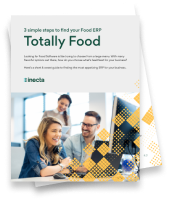In today’s food industry, artificial intelligence (AI) is becoming an essential tool for forecasting demand, optimizing pricing, reducing waste, and improving operational efficiency. But here’s the truth few talk about: AI is only as good as the data it’s fed.
For most food businesses, ERP data isn’t ready for AI out of the box. It’s often scattered across departments, formatted inconsistently, and mixed with human errors or duplicate records. That’s where ETL — Extract, Transform, Load —becomes the missing link.
The Problem: Messy Data Is Holding Back Your AI
Even the most advanced ERP system collects data from multiple sources — purchasing, production, sales, logistics, and finance. Without ETL, this data remains siloed and inconsistent.
Common challenges:
-
Mismatched units of measure between departments
-
Duplicate vendor or customer records
-
Missing or outdated product attributes
-
Manual data entry errors
-
Separate systems storing overlapping but unsynced data
AI tools need structured, accurate, and consistent data to deliver reliable insights. Feeding messy data into an AI model is like putting spoiled ingredients into a recipe — the results will be disappointing.

The Role of ETL in AI Readiness
ETL works in three phases:
-
Extract — Pulls data from all your sources, including ERP modules, external apps, and legacy systems.
-
Transform — Cleans, standardizes, and enriches the data. This may include converting measurements, removing duplicates, filling missing values, and applying consistent naming conventions.
-
Load — Delivers the cleaned dataset into a central, AI-ready data warehouse or back into your ERP.
By automating these steps, ETL ensures that AI tools get one version of the truth — without the inconsistencies and noise that cause errors.

ETL in Action: From ERP Data to AI-Driven Decisions
With ETL in place, your ERP data becomes a powerful fuel source for AI. Here’s how it works in real-world food business scenarios:
-
Demand Forecasting: AI can analyze historical sales, seasonal patterns, and promotions to predict future demand with high accuracy.
-
Pricing Optimization: Dynamic pricing models can adjust prices based on costs, competitor trends, and inventory levels.
-
Waste Reduction: By analyzing spoilage rates, sales velocity, and supplier performance, AI can recommend smarter purchasing strategies.
-
Production Planning: AI can optimize scheduling based on raw material availability, labor constraints, and customer demand.

Why Food Businesses Can’t Skip This Step
Skipping ETL and jumping straight to AI is like building a house on sand — the foundation won’t hold. ETL:
-
Improves trust in AI-generated insights
-
Reduces the manual workload of preparing reports
-
Speeds up the AI implementation timeline
-
Future-proofs your ERP for new technologies
In an industry where margins are tight and efficiency is everything, clean, structured data isn’t optional — it’s a competitive advantage.

Final Takeaway
If you’re planning to integrate AI into your ERP-driven operations, start by investing in ETL. It’s the step that ensures your AI is working with the best possible data — so you get insights you can trust, every time.











Free Valuable Resource!
3 simple steps to find your Food ERP
Free Valuable Resource!
3 simple steps to find your Food ERP
*We will never sell your information. Keeping your data and privacy secure is our highest concern.